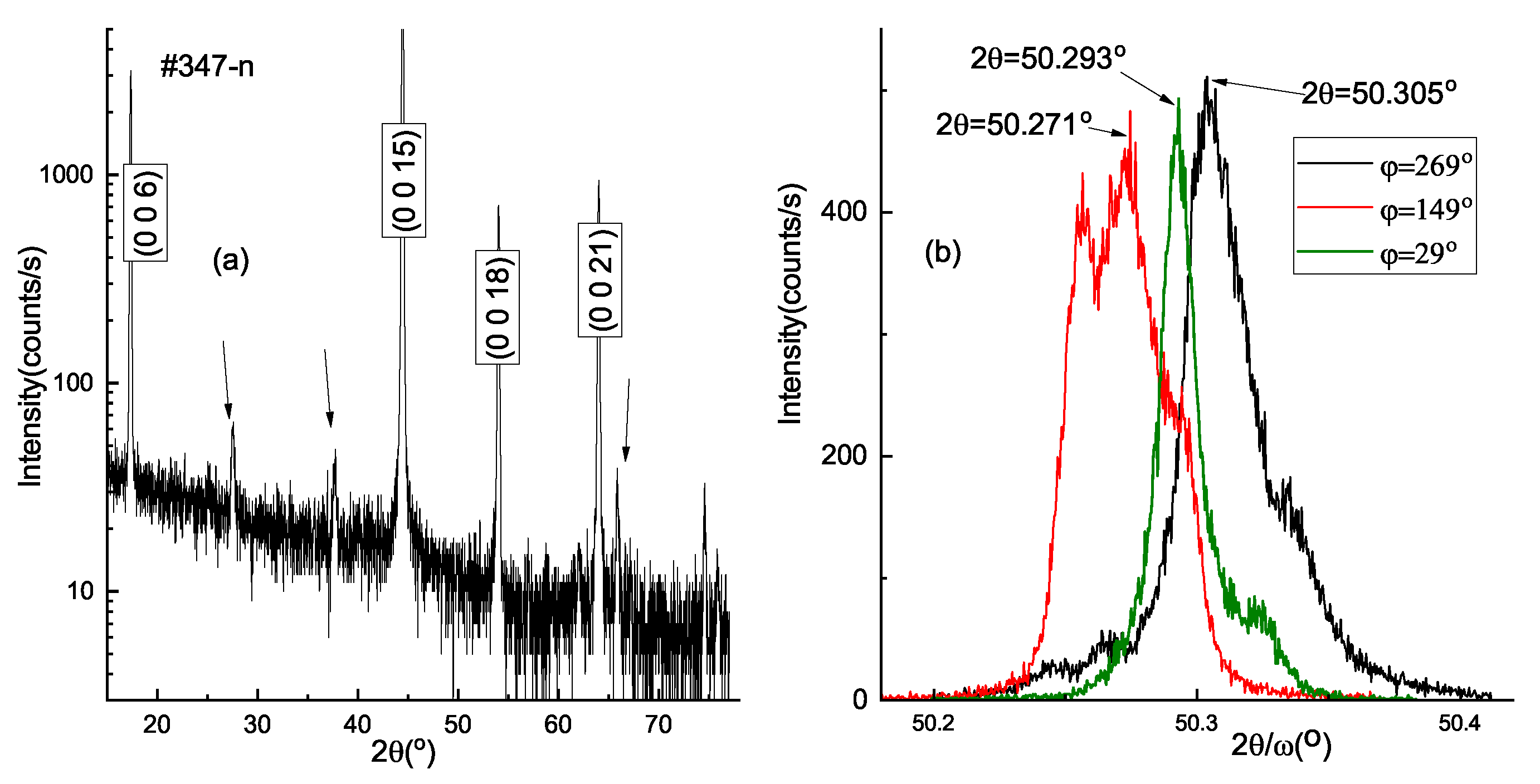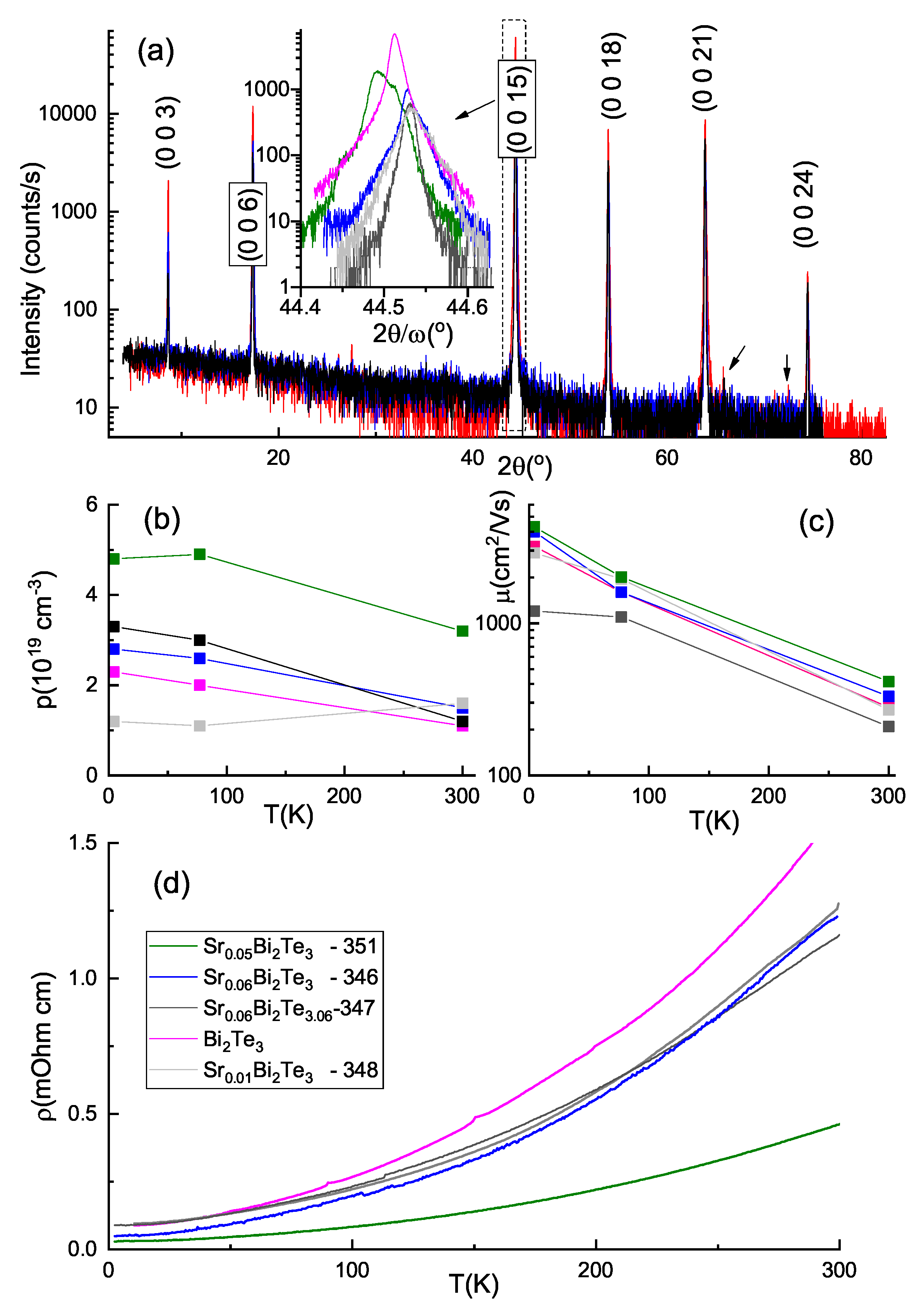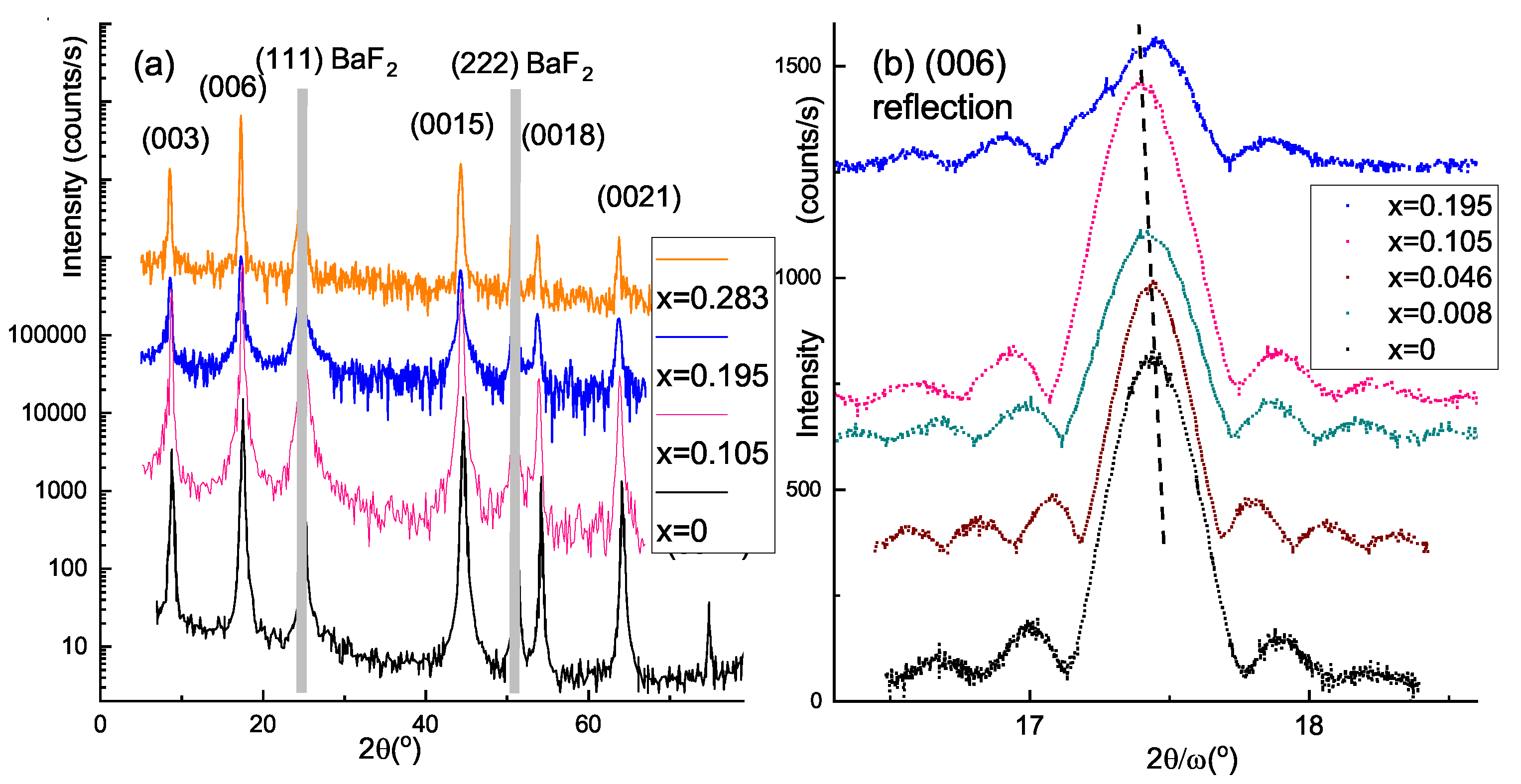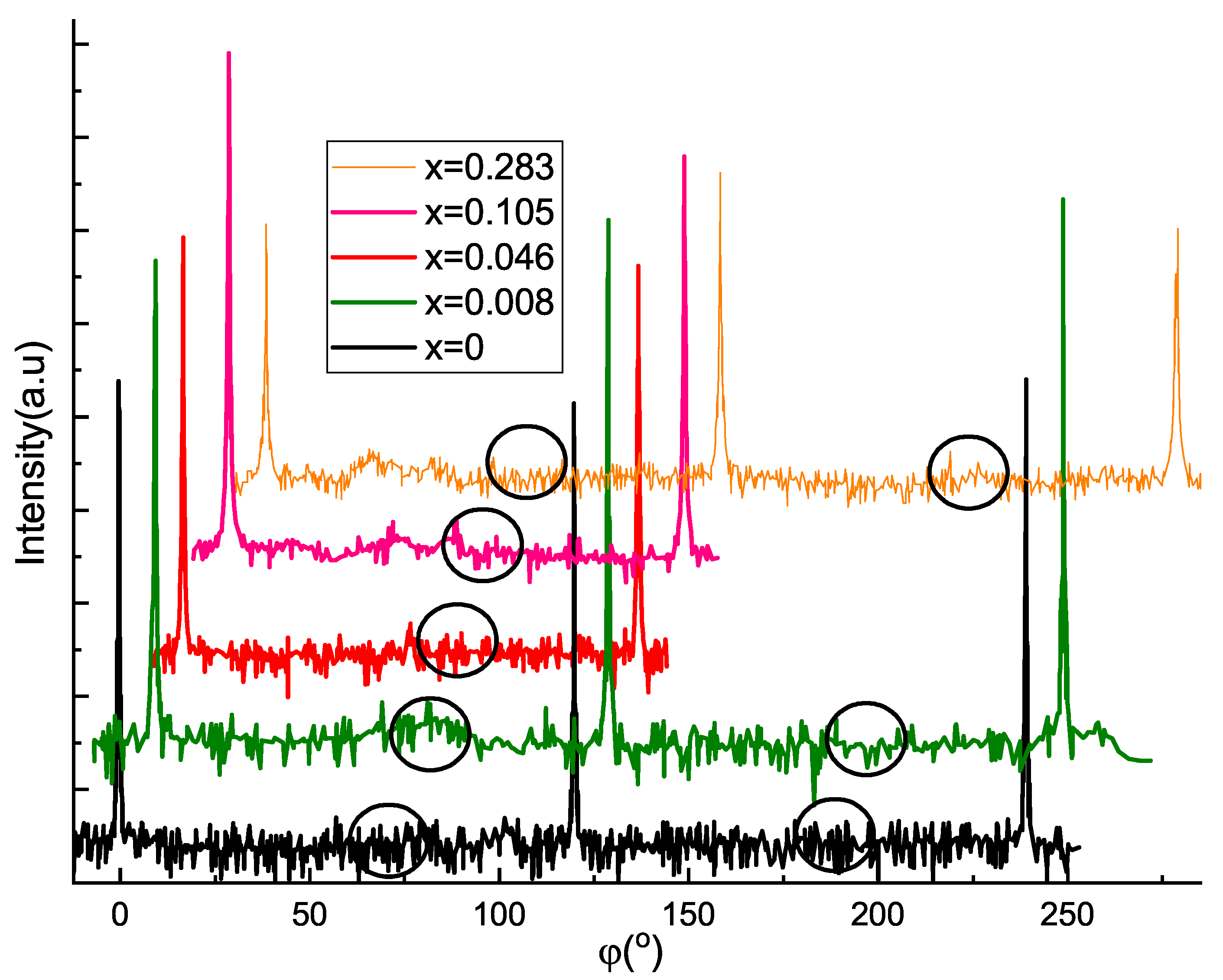Effect of Sr Doping on Structural and Transport Properties of Bi2Te3
Abstract
:1. Introduction
2. Materials and Methods
2.1. Growth and Characterization Techniques
2.2. X-ray Diffraction
2.3. Transport Measurements
3. Results
3.1. Single Crystals
3.2. Structural Results on Thin Films
3.3. Transport Measurements on Thin Films
4. Discussion
5. Conclusions
Author Contributions
Funding
Institutional Review Board Statement
Informed Consent Statement
Data Availability Statement
Acknowledgments
Conflicts of Interest
Abbreviations
| XRD | X-ray diffraction |
| XRR | X-ray reflection |
| MBE | Molecular beam epitaxy |
| TSC | Topological superconductivity |
| 3D | Three-dimensional |
| TI | Topological insulator |
| BEP | beam equivalent pressure |
| CFMS | Cryomagnetic measurement system |
| BL | bilayer |
| QL | quintuple layer |
Appendix A. XRD Determination of Admixture Phases and Lattice Parameters in Single Crystals

References
- Heremans, J.P.; Cava, R.J.; Samarth, N. Tetradymites as thermoelectrics and topological insulators. Nat. Rev. Mater. 2017, 2, 17049. [Google Scholar] [CrossRef]
- Tokura, Y.; Yasuda, K.; Tsukazaki, A. Magnetic topological insulators. Nat. Rev. Phys. 2019, 1, 126–143. [Google Scholar] [CrossRef]
- Yonezawa, S. Nematic Superconductivity in Doped Bi2Se3 Topological Superconductors. Condens. Matted 2019, 4, 2. [Google Scholar] [CrossRef] [Green Version]
- Zhang, H.; Zhang, X.; Liu, C.; Lee, S.-T.; Jie, J. High-Responsivity, High-Detectivity, Ultrafast Topological Insulator Bi2Se3/Silicon Heterostructure Broadband Photodetectors. ACS Nano 2016, 10, 5113. [Google Scholar] [CrossRef] [PubMed]
- Koo, J.; Ashok, N.; Kim, D.H.; Shin, W. Bi2Te3 Topological Insulator for Domain-Wall Dark Pulse Generation from Thulium-Doped Fiber Laser. Crystals 2019, 9, 337. [Google Scholar] [CrossRef] [Green Version]
- Elliott, S.R.; Franz, M. Colloquium: Majorana fermions in nuclear, particle, and solid-state physics. Reviws Mod. Phys. 2015, 87, 137. [Google Scholar] [CrossRef] [Green Version]
- Fu, L.; Kane, C.L. Superconducting Proximity Effect and Majorana Fermions at the Surface of a Topological Insulator. Phys. Rev. Lett. 2008, 100, 096407. [Google Scholar] [CrossRef] [PubMed] [Green Version]
- Das Sarma, S.; Freedman, M.; Nayak, C. Majorana zero modes and topological quantum computation. Npj Quantum Inf. 2015, 1, 15001. [Google Scholar] [CrossRef] [Green Version]
- Sato, M.; Ando, Y. Topological superconductors: A review. Rep. Prog. Phys. 2017, 80, 076501. [Google Scholar] [CrossRef] [PubMed] [Green Version]
- Sasaki, S.; Kriener, M.; Segawa, K.; Yada, K.; Tanaka, Y.; Sato, M.; Ando, Y. Topological Superconductivity in CuxBi2Se3. Phys. Rev. Lett. 2011, 107, 217001. [Google Scholar] [CrossRef] [PubMed] [Green Version]
- Tao, R.; Yan, Y.-J.; Liu, X.; Wang, X.; Ando, Y.; Wang, Q.-H.; Zhang, Q.-H.; Feng, D.-L. Direct Visualization of the Nematic Superconductivity in CuxBi2Se3. Phys. Rev. 2018, 8, 041024. [Google Scholar] [CrossRef] [Green Version]
- Qi, X.-L.; Zhang, S.-C. Topological insulators and superconductors. Rev. Mod. Phys. 2011, 83, 1057. [Google Scholar] [CrossRef] [Green Version]
- Kirshenbaum, K.; Syers, P.S.; Hope, A.P.; Butch, N.P.; Jeffries, J.R.; Weir, S.T.; Hamlin, J.J.; Maple, M.B.; Vohra, Y.K.; Paglione, J. Pressure-Induced Unconventional Superconducting Phase in the Topological Insulator Bi2Se3. Phys. Rev. Lett. 2013, 111, 087001. [Google Scholar] [CrossRef] [PubMed] [Green Version]
- Zhang, J.L.; Zhang, S.J.; Weng, H.M.; Zhang, W.; Yang, L.X.; Liu, Q.Q.; Feng, S.M.; Wang, X.C.; Yu, R.C.; Cao, L.Z.; et al. Pressure-induced Superconductivity in Topological Parent Compound Bi2Te3. Proc. Natl. Acad. Sci. USA 2011, 108, 24. [Google Scholar] [CrossRef] [Green Version]
- Li, Y.; Xu, Z.-A. Exploring Topological Superconductivity in Topological Materials. Adv. Quantum Technol. 2019, 2, 1800112. [Google Scholar] [CrossRef]
- Hor, Y.S.; Williams, A.J.; Checkelsky, J.G.; Roushan, P.; Seo, J.; Xu, Q.; Zandbergen, H.W.; Yazdani, A.; Ong, N.P.; Cava, R.J. Superconductivity in CuxBi2Se3 and its Implications for Pairing in the Undoped Topological Insulator. Phys. Rev. Lett. 2010, 104, 057001. [Google Scholar] [CrossRef] [Green Version]
- Liu, Z.; Yao, X.; Shao, J.; Zuo, M.; Pi, L.; Tan, S.; Zhang, C.; Zhang, Y. Superconductivity with topological surface state in SrxBi2Se3. J. Am. Chem. Soc. 2015, 137, 10512–10515. [Google Scholar] [CrossRef] [PubMed] [Green Version]
- Pan, Y.; Nikitin, A.M.; Araizi, G.K.; Huang, Y.K.; Matsushita, Y.; Naka, T.; de Visser, A. Rotational symmetry breaking in the topological superconductor SrxBi2Se3 probed by upper-critical field experiments. Sci. Rep. 2016, 6, 28632. [Google Scholar] [CrossRef]
- Kuntsevich, A.Y.; Bryzgalov, M.A.; Prudkoglyad, V.A.; Martovitskii, V.P.; Selivanov, Y.G.; Chizhevskii, E.G. Structural distortion behind the nematic superconductivity in SrxBi2Se3. New J. Phys. 2018, 20, 103022. [Google Scholar] [CrossRef]
- Kuntsevich, A.Y.; Bryzgalov, M.A.; Akzyanov, R.S.; Martovitskii, V.P.; Rakhmanov, A.L.; Selivanov, Y.G. Strain-driven nematicity of odd-parity superconductivity in SrxBi2Se3. Phys. Rev. B 2019, 101, 224509. [Google Scholar] [CrossRef] [Green Version]
- Almoalem, A.; Silber, I.; Sandik, S.; Lotem, M.; Ribak, A.; Nitzav, Y.; Kuntsevich, A.Y.; Sobolevskiy, O.A.; Selivanov, Y.G.; Prudkoglyad, V.A. Link between superconductivity and a Lifshitz transition in intercalated Bi2Se3. Phys. Rev. B 2021, 103, 174518. [Google Scholar] [CrossRef]
- Asaba, T.; Lawson, B.J.; Tinsman, C.; Chen, L.; Corbae, P.; Li, G.; Qiu, Y.; Hor, Y.S.; Fu, L.; Li, L. Rotational Symmetry Breaking in a Trigonal Superconductor Nb-doped Bi2Se3. Phys. Rev. X 2017, 7, 011009. [Google Scholar] [CrossRef] [Green Version]
- Hor, Y.S.; Checkelsky, Y.S.; Qu, D.; Ong, N.P.; Cava, R.J. Superconductivity and non-metallicity induced by doping the topological insulators Bi2Se3 and Bi2Te3. J. Phys. Chem. Solids 2011, 72, 572–576. [Google Scholar] [CrossRef] [Green Version]
- Trang, C.X.; Wang, Z.; Takane, D.; Nakayama, K.; Souma, S.; Sato, T.; Takahashi, T.; Taskin, A.A.; Ando, Y. Fermiology of possible topological superconductor Tl0.5Bi2Te3 derived from hole-doped topological insulator. Phys. Rev. B 2016, 93, 241103. [Google Scholar] [CrossRef] [Green Version]
- Singh, Y. The H-T and P-T Phase Diagram of the Superconducting Phase in Pd:Bi2T3. J. Supercondunc. Nov. Magn. 2016, 29, 1975. [Google Scholar]
- Sharma, M.M.; Sang, L.; Rani, P.; Wang, X.L.; Awana, V.P.S. Superconductivity below 6K in PdBi2Te3 Single crystal. J. Supercond. Nov. Magn. 2020, 33, 1243. [Google Scholar] [CrossRef] [Green Version]
- Wang, Z.; Taskin, A.A.; Frölich, T.; Braden, M.; Ando, Y. Superconductivity in Tl0.6Bi2Te3 Derived from a Topological Insulator. Chem. Mater. 2016, 28, 779. [Google Scholar] [CrossRef] [Green Version]
- He, L.Q.; Liu, H.; He, M.; Lai, Y.H.; He, H.; Wang, G.; Law, K.T.; Lortz, R.; Wang, J.; Sou, I.K. Two-dimensional superconductivity at the interface of a Bi2Te3/FeTe heterostructure. Nat. Commun. 2014, 5, 4247. [Google Scholar] [CrossRef]
- Yasuda, K.; Yasuda, H.; Liang, T.; Yoshimi, R.; Tsukazaki, A.; Takahashi, K.S.; Nagaosa, N.; Kawasaki, M.; Tokura, Y. Nonreciprocal charge transport at topological insulator/superconductor interface. Nat. Commmun. 2019, 10, 2734. [Google Scholar] [CrossRef] [PubMed]
- Qin, H.; Guo, B.; Wang, L.; Zhang, M.; Xu, B.; Shi, K.; Pan, T.; Zhou, L.; Chen, J.; Qiu, Y.; et al. Superconductivity in Single-Quintuple-Layer Bi2Te3 Grown on Epitaxial FeTe. Nano Lett. 2020, 20, 3160. [Google Scholar] [CrossRef]
- Volosheniuk, S.O.; Selivanov, Y.G.; Bryzgalov, M.A.; Martovitskii, V.P.; Kuntsevich, A.Y. Effect of Sr doping on structure, morphology, and transport properties of Bi2Se3 epitaxial thin films. J. Appl. Phys. 2019, 125, 095103. [Google Scholar] [CrossRef] [Green Version]
- Schneeloch, J.A.; Zhong, R.D.; Xu, Z.J.; Gu, G.D.; Tranquada, J.M. Dependence of superconductivity in CuxBi2Se3 on quenching conditions. Phys. Rev. B 2015, 91, 144506. [Google Scholar] [CrossRef] [Green Version]
- Kuntsevich, A.Y.; Gabdullin, A.A.; Prudkogliad, V.A.; Selivanov, Y.G.; Chizhevskii, E.G.; Pudalov, V.M. Low-temperature Hall effect in bismuth chalcogenides thin films. Phys. Rev. B 2016, 94, 235401. [Google Scholar] [CrossRef] [Green Version]
- Caha, O.; Dubroka, A.; Humlicek, J.; Holy, V.; Steiner, H.; Ul-Hassan, M.; Sanchez-Barriga, J.; Rader, O.; Stanislavchuk, T.N.; Sirenko, A.A.; et al. Growth, structure, and electronic properties of epitaxial bismuth telluride topological insulator films on BaF2 (111) substrates. Cryst. Growth Des. 2013, 13, 3365. [Google Scholar] [CrossRef]
- Kuntsevich, A.Y.; Martovitskii, V.P.; Rybalchenko, G.V.; Selivanov, Y.G.; Bannikov, M.I.; Sobolevskiy, O.A.; Chigevskii, E.G. Superconductivity in Cu co-doped SrxBi2Se3 single crystals. Materials 2019, 12, 3899. [Google Scholar] [CrossRef] [Green Version]
- Martovitskii, V.P.; Selivanov, Y.G.; Kuntsevich, A.Y. Vicinal Growth as a Possible Structural Source of the Nematic Superconductivity in SrxBi2Se3. Bull. Lebedev Phys. Inst. 2020, 47, 119–122. [Google Scholar] [CrossRef]
- Fewster, P.F. X-ray Scattering from Semiconductors; Imperial College Press: London, UK, 2003. [Google Scholar]
- Kamenskyi, D.L.; Pronin, A.V.; Benia, H.M.; Martovitskii, V.P.; Pervakov, K.S.; Selivanov, Y.G. Bulk Cyclotron Resonance in the Topological Insulator Bi2Te3. Crystals 2020, 10, 722. [Google Scholar] [CrossRef]
- Bos, J.W.G.; Zandbergen, H.W.; Lee, M.-H.; Ong, N.P.; Cava, R.J. Structures and thermoelectric properties of the infinitely adaptive series (Bi2)m(Bi2Te3)n. Phys. Rev. B 2007, 75, 195203. [Google Scholar] [CrossRef] [Green Version]
- Fornari, C.I.; Rappl, P.H.O.; Morelhão, S.L.; Abramof, E. Structural properties of Bi2Te3 topological insulator thin films grown by molecular beam epitaxy on (111) BaF2 substrates. J. Appl. Phys. 2016, 119, 165303. [Google Scholar] [CrossRef]
- Fulop, A.; Song, A.; Charpentier, S.; Shi, P.; Ekström, M.; Galletti, L.; Arpaia, R.; Bauch, T.; Lombardi, F.; Wang, S. Phase transition of bismuth telluride thin films grown by MBE. Appl. Phys. Express 2014, 7, 045503. [Google Scholar] [CrossRef]
- Lee, J.S.; Richardella, A.; Rench, D.W.; Fraleigh, R.D.; Flanagan, T.C.; Borchers, J.A.; Tao, J.; Samarth, N. Ferromagnetism and spin-dependent transport in n-type Mn-doped bismuth telluride thin films. Phys. Rev. B 2014, 89, 174425. [Google Scholar] [CrossRef] [Green Version]
- Balin, K.; Wojtyniak, M.; Weis, M.; Zubko, M.; Wilk, B.; Gu, R.; Ruello, P.; Szade, J. Europium Doping Impact on the Properties of MBE Grown Bi2Te3 Thin Film. Materials 2020, 13, 3111. [Google Scholar] [CrossRef]
- Kagerer, P.; Fornari, C.I.; Buchberger, S.; Morelhão, S.L.; Vidal, R.C.; Tcakaev, A.; Zabolotnyy, V.; Weschke, E.; Hinkov, V.; Kamp, M.; et al. Molecular beam epitaxy of antiferromagnetic (MnBi2Te4)(Bi2Te3) thin films on BaF2 (111). J. Appl. Phys. 2020, 128, 135303. [Google Scholar] [CrossRef]
- Steiner, H.; Volobuev, V.; Caha, O.; Bauer, G.; Springholz, G.; Holỳ, V. Structure and composition of bismuth telluride topological insulators grown by molecular beam epitaxy. J. Appl. Cryst. 2014, 47, 1889–1900. [Google Scholar] [CrossRef]
- Kriegner, D.; Harcuba, P.; Veselý, J.; Lesnik, A.; Bauer, G.; Springholz, G.; Holỳ, V. Twin domain imaging in topological insulator Bi2Te3 and Bi2Se3 epitaxial thin films by scanning X-ray nanobeam microscopy and electron backscatter diffraction. J. Appl. Cryst. 2017, 50, 369–377. [Google Scholar] [CrossRef] [Green Version]
- Lin, Y.-R.; Bagchi, M.; Soubatch, S.; Lee, T.-L.; Brede, J.; Bocquet, F.C.; Kumpf, C.; Ando, Y.; Tautz, F.S. Vertical Position of Sr Dopants in the SrxBi2Se3. Phys. Rev. B 2021, 104, 054506. [Google Scholar] [CrossRef]






| Sample | x | d (nm) | (Å) | (Å) | a(Å) | RRR | n (cm) | (cm/Vs) | |
|---|---|---|---|---|---|---|---|---|---|
| 773A | 0 | 27.8 | 30.4839 | 30.5053 | 4.3835 | 0.088 | 3 | 1020 | |
| 774 | 0.0084 | 34.7 | 30.4890 | 30.5020 | 4.3831 | - | 2.14 | 428 | |
| 799 | 0.0168 | 31 | - | 30.5313 | 4.3827 | 0.189 | 1.97 | 447 | |
| 786A | 0.046 | 28 | 30.5270 | 30.5404 | 4.3830 | 0.180 | 2.2 | 213 | |
| 787A | 0.105 | 26 | 30.5534 | 30.5640 | 4.3839 | 0.209 | 1.828 | 206 | |
| 794A | 0.195 | 27 | - | 30.6065 | 4.3832 | 0.253 | 1.4 | 80 | |
| 798A | 0.283 | 29 | - | 30.592 | 4.3866 | 2 peaks | 1.1 | 13 |
| Composition | c (Å) | a (Å) | () | () |
|---|---|---|---|---|
| BiTe | 30.6065 | 4.3835 | 11.799 | 82.93 |
| BiTe | 24.002 | 4.402 | 11.806 | 80.98 |
| BiTe | 41.50 | 4.416 | 11.670 | 84.73 |
Publisher’s Note: MDPI stays neutral with regard to jurisdictional claims in published maps and institutional affiliations. |
© 2021 by the authors. Licensee MDPI, Basel, Switzerland. This article is an open access article distributed under the terms and conditions of the Creative Commons Attribution (CC BY) license (https://creativecommons.org/licenses/by/4.0/).
Share and Cite
Selivanov, Y.G.; Martovitskii, V.P.; Bannikov, M.I.; Kuntsevich, A.Y. Effect of Sr Doping on Structural and Transport Properties of Bi2Te3. Materials 2021, 14, 7528. https://doi.org/10.3390/ma14247528
Selivanov YG, Martovitskii VP, Bannikov MI, Kuntsevich AY. Effect of Sr Doping on Structural and Transport Properties of Bi2Te3. Materials. 2021; 14(24):7528. https://doi.org/10.3390/ma14247528
Chicago/Turabian StyleSelivanov, Yurii G., Victor P. Martovitskii, Mikhail I. Bannikov, and Aleksandr Y. Kuntsevich. 2021. "Effect of Sr Doping on Structural and Transport Properties of Bi2Te3" Materials 14, no. 24: 7528. https://doi.org/10.3390/ma14247528
APA StyleSelivanov, Y. G., Martovitskii, V. P., Bannikov, M. I., & Kuntsevich, A. Y. (2021). Effect of Sr Doping on Structural and Transport Properties of Bi2Te3. Materials, 14(24), 7528. https://doi.org/10.3390/ma14247528







